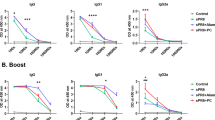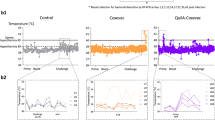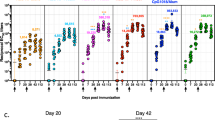Abstract
Freund's complete adjuvant (FCA) is a commonly used immunopotentiator that can boost polyclonal antibody production in animal models such as rabbits, but FCA is also known to cause inflammation and pain. It is important to balance the welfare of animals with the goal of efficiently producing antibodies, but little is known about how common treatments for pain and inflammation, such as non-steroidal anti-inflammatory drugs (NSAIDs), affect the production of polyclonal antibodies. The purpose of this study was to measure polyclonal antibody production in rabbits that were administered FCA either with or without a concurrent treatment of a NSAID, carprofen. Rabbits were divided into two groups and were administered identical treatments of an antigen with adjuvant, and the treatment group also received carprofen injections at different stages of the study. Carprofen treatment did not significantly affect polyclonal antibody production, which suggests that carprofen and other NSAIDs can be used alongside FCA in rabbits to achieve desired levels of antibody production while minimizing pain and distress associated with the use of FCA.
This is a preview of subscription content, access via your institution
Access options


Similar content being viewed by others
Change history
27 January 2016
In the version of this article published in print, the affiliation for the five authors was omitted. The error was corrected in the HTML and PDF versions of the article before online publication.
References
Legge, T.M. & Oxon, M.D. The Milroy lectures on industrial anthrax: delivered before the Royal College of Physicians of London. BMJ 1, 589–593 (1905).
Leenaars, P.P., Hendriksen, C.F.M., Angulo, A.F., Koedam, M.A. & Claassen, E. Evaluation of several adjuvants as alternatives to the use of Freund's adjuvant in rabbits. Vet. Immunol. Immunopathol. 40, 225–241 (1994).
Lipman, N.S., Trudel, L.J., Murphy, J.C. & Sahali, Y. Comparison of immune response potentiation and in vivo inflammatory effects of Freund's and RIBI adjuvants in mice. Lab. Anim. Sci. 42, 193–197 (1992).
Johnston, B.A., Eisen, H. & Fry, D. An evaluation of several adjuvant emulsion regimens for the production of polyclonal antisera in rabbits. Lab. Anim. Sci. 41, 15–21 (1991).
Mallon, F.M., Graichen, M.E., Conway, B.R., Landi, M.S. & Hughes, H.C. Comparison of antibody response by use of synthetic adjuvant system and Freund complete adjuvant in rabbits. Am. J. Vet. Res. 52, 1503–1506 (1991).
Smith, D.E., O'Brien, M.E., Palmer, V.J. & Sadowski, J.A. The selection of an adjuvant emulsion for polyclonal antibody production using a low-molecular-weight antigen in rabbits. Lab. Anim. Sci. 42, 599–601 (1992).
Stills, H.F. Adjuvants and antibody production: dispelling the myths associated with Freund's complete and other adjuvants. ILAR J. 46, 280–293 (2005).
Stills, H.F. & Bailey, M.Q. The use of Freund's complete adjuvant. Lab. Anim. Sci. 20, 25–31 (1991).
Broderson, J.R. A retrospective review of lesions associated with the use of Freund's adjuvant. Lab. Anim. Sci. 39, 400–405 (1989).
Jackson, L.R. & Fox, J.G. Institutional policies and guidelines on adjuvants and antibody production. ILAR J. 37, 141–152 (1995).
Amyx, H.L. Control of animal pain and distress in antibody production and infectious disease studies. J. Am. Vet. Med. Assoc. 191, 1287–1289 (1987).
US Department of Agriculture. Animal Care Policy Manual. (USDA, Riverdale, MD, 2015).
Animal Welfare Regulations. 2008. Code of Federal Regulations. Title 9, Part 2, Subpart C.
Animal Welfare Act as Amended. 2008. United States Code. Title 7, Chapter 54, Section 2143.
National Research Council (US) Committee on Recognition and Alleviation of Pain in Laboratory Animals. Recognition and Alleviation of Pain in Laboratory Animals (National Academies Press, Washington, DC, 2009).
Institute for Laboratory Animal Research. Guide for the Care and Use of Laboratory Animals 8th edn. (National Academies Press, Washington, DC, 2011).
American College of Laboratory Animal Medicine. Guidelines for the Assessment and Management of Pain in Rodents and Rabbits (American College of Laboratory Animal Medicine, 2006). http://www.aclam.org/Content/files/files/Public/Active/position_pain-rodent-rabbit.pdf.
Kolstad, A.M., Rodriguiz, R.M., Kim, C.J. & Hale, L.P. Effect of pain management on immunization efficacy in mice. J. Am. Assoc. Lab. Anim. Sci. 51, 448–457 (2012).
Halliday, L.C., Artwohl, J.E., Hanly, W.C., Bunte, R.M. & Bennett, B.T. Physiologic and behavioral assessment of rabbits immunized with Freund's complete adjuvant. Contemp. Top. Lab. Anim. Sci. 39, 8–13 (2000).
Halliday, L.C., Artwohl, J.E., Bunte, R.M., Ramakrishnan, V. & Bennett, B.T. Effects of Freund's complete adjuvant on the physiology, histology, and activity of New Zealand White Rabbits. Contemp. Top. Lab. Anim. Sci. 43, 8–13 (2004).
Ben-Baruch, A. Inflammation-associated immune suppression in cancer: The roles played by cytokines, chemokines and additional mediators. Semin. Cancer Biol. 16, 38–52 (2006).
Cho, J.Y. Immunomodulatory effect of nonsteroidal anti-inflammatory drugs (NSAIDs) at the clinically available doses. Arch. Pharm. Res. 30, 64–74 (2007).
Hussain, M., Javeed, A., Ashraf, M., Al-Zaubai, N., Stewart, A. & Mahmood-Mukhtar, M. Non-steroidal anti-inflammatory drugs, tumour immunity and immunotherapy. Pharmacol. Res. 66, 7–18 (2012).
Vane, J.R. Inhibition of prostaglandin synthesis as a mechanism of action for aspirin-like drugs. Nat. New Biol. 231, 232–235 (1971).
Acknowledgements
We thank Ms. Sabrina Stronsky, Dr. Pamela Glass, MAJ Amy Carlson and Mr. William Discher for their assistance and support of this project. The opinions, interpretations, conclusions and recommendations are those of the authors and not necessarily endorsed by the US Army.
Author information
Authors and Affiliations
Corresponding author
Ethics declarations
Competing interests
The authors declare no competing financial interests.
Rights and permissions
About this article
Cite this article
Fishback, J., Stronsky, S., Green, C. et al. Antibody production in rabbits administered Freund's complete adjuvant and carprofen concurrently. Lab Anim 45, 63–66 (2016). https://doi.org/10.1038/laban.937
Received:
Accepted:
Published:
Issue Date:
DOI: https://doi.org/10.1038/laban.937



